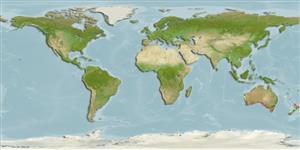>
Kurtiformes (Nurseryfishes, cardinalfishes.) >
Apogonidae (Cardinalfishes) > Apogoninae
Etymology: Siphamia: A Swazi word, siphama, for a fish.
More on author: Castelnau.
Environment: milieu / climate zone / depth range / distribution range
Écologie
marin; saumâtre benthopélagique; profondeur 0 - 7 m (Ref. 57178). Temperate; 25°S - 45°S
Eastern Indian Ocean: endemic to southern Australia, from Shark Bay, Western Australia to Byron Bay, New South Wales.
Taille / Poids / Âge
Maturity: Lm ? range ? - ? cm
Max length : 5.0 cm SL mâle / non sexé; (Ref. 26498)
Description synthétique
Morphologie | Morphométrie
Épines dorsales (Total): 7; Rayons mous dorsaux (Total): 8; Épines anales 2; Rayons mous anaux: 8 - 9. This species is distinguished by the following characters: D1 VI, D2 I,8 (rarely 7 or 9 soft rays); A II,8-9; pectoral fin rays 12-14, unbranched and compressed distally; tubed lateral-line scales 22-23; median predorsal scales 4-5; total gill rakers 4-6 + 14-16, developed gill rakers 1-3 + 13-16 = 15-18; gill rakers on ceratobranchial 9-10; body relatively slender, depth 3.2-4.8 in SL, and body width 1.6-1.8 in the depth; eye diameter 3.2-3.7 in HL; first dorsal spine 1.1-1.3 in second spine; second dorsal spine 2.6-3.6, spine of second dorsal fin 5.1-6.7, and second anal spine 6.0-7.4, all in
head length (HL); pectoral-fin length 5.8-6.7 and pelvic-fin length 5.7-6.1 in SL; caudal-peduncle length 1.05-1.4 in distance between pelvic spine insertion and anal-fin origin; preopercular edge and ridge smooth, with the ventral edge weakly ossified and usually slightly crenulate; palatines with 1-3 series of small teeth; first infraorbital pore a complex of about 7 small pores; scales large, mostly ctenoid; tubed lateral-line scales with vertical series of papillae; the tip of light organ on each side of tongue bound by membrane (Ref. 90035).
Benthic species (Ref. 75154) which occurs over soft bottom in coastal embayments and in the lower reaches of estuaries (Ref. 33616). It is found usually in schools near kelp or seagrass beds of Zostera or Posidonia at depths of 1-10 m (Ref. 90035).
Life cycle and mating behavior
Maturité | Reproduction | Frai | Œufs | Fécondité | Larves
Mouthbrooders (Ref. 240). Distinct pairing during courtship and spawning (Ref. 205). Adults in South Australian waters have been observed brooding eggs in January (Ref. 33616).
Gon, O. and G.R. Allen, 2012. Revision of the Indo-Pacific cardinalfish genus Siphamia (Perciformes: Apogonidae). Zootaxa 3294:1-84. (Ref. 90035)
Statut dans la liste rouge de l'IUCN (Ref. 130435)
Menace pour l'homme
Harmless
Utilisations par l'homme
Plus d'informations
PaysZones FAOÉcosystèmesOccurrencesIntroductionsStocksÉcologieRégime alimentaireÉléments du régime alimentaireConsommation alimentaireRation
Taille/ÂgeCroissanceLongueur-poidsLongueur-longueurFréquences de longueursMorphométrieMorphologieLarvesDynamique des populations larvairesRecrutementAbondanceBRUVS
RéférencesAquacultureProfil d'aquacultureSouchesGénétiqueElectrophoresesHéritabilitéPathologiesTraitementNutrientsMass conversion
CollaborateursImagesStamps, Coins Misc.SonsCiguateraVitesseType de nageSurface branchialeOtolithesCerveauxVision
Outils
Articles particuliers
Télécharger en XML
Sources Internet
Estimates based on models
Preferred temperature (Ref.
123201): 15.3 - 22, mean 17.8 °C (based on 286 cells).
Phylogenetic diversity index (Ref.
82804): PD
50 = 0.5000 [Uniqueness, from 0.5 = low to 2.0 = high].
Bayesian length-weight: a=0.01479 (0.00690 - 0.03171), b=3.09 (2.91 - 3.27), in cm total length, based on LWR estimates for this (Sub)family-body shape (Ref.
93245).
Niveau trophique (Ref.
69278): 3.4 ±0.5 se; based on size and trophs of closest relatives
Résilience (Ref.
120179): Haut, temps minimum de doublement de population inférieur à 15 mois (Preliminary K or Fecundity.).
Fishing Vulnerability (Ref.
59153): Low vulnerability (10 of 100).
Nutrients (Ref.
124155): Calcium = 171 [83, 476] mg/100g; Iron = 0.735 [0.314, 1.596] mg/100g; Protein = 17.7 [16.3, 19.1] %; Omega3 = 0.523 [0.170, 1.648] g/100g; Selenium = 9.35 [2.99, 29.26] μg/100g; VitaminA = 15.4 [2.9, 73.9] μg/100g; Zinc = 1.66 [0.94, 2.87] mg/100g (wet weight);
